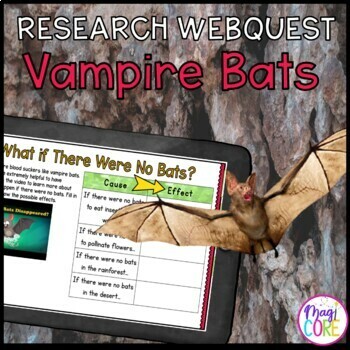Vampire Bats Digital Research WebQuest Activity Nonfiction Science Reading
- Google Drive™ folder
- Internet Activities

What educators are saying
Also included in
- The Creepy Animals internet research Webquest activity bundle contains four creepy animal Research Webquests PLUS a BONUS Animal Report Writing Printable. Each low-prep webquest is focused on a weird and creepy animal such as anacondas, black widows, vampire bats, and the infamous anglerfish. StudenPrice $9.50Original Price $14.00Save $4.50
Description
In this low- prep digital research Webquest activity, students learn all about Vampire Bats through nonfiction reading and science activities.
⭐️Students will learn about what Vampire Bats are, how to classify bats, the Vampire Bat anatomy, why bats hang upside down, how do bats hunt, what's inside a bat cave, and more! This Webquest in Google slide contains video links, images, reading passages, exercises, research practice, writing activities, and more.
⭐️This resource integrates a variety of research, writing, critical thinking, and reading skills. Students complete activities along with watching videos and completing thought-provoking exercises. Incorporates key text features, reading comprehension, writing, multimedia, interdisciplinary studies, and other skills.
*Please note: This resource includes links to YouTube videos, so ensure you and your students have access to YouTube before purchasing. Although great care has been taken to ensure all content is appropriate for the stated grade levels, each classroom is unique and it is recommended that teachers review all content prior to use. I recommend embedding the videos to avoid ads and other content that may be inappropriate. Instructions for embedding the videos are included and it should only take a few minutes. Also, keep in mind that any links to third-party content may be changed or removed by the content owner. All links are reviewed regularly; however, if you find a broken link, please let me know so I can update the resource accordingly.
Features:
✏️Google Slides Format - This interactive format is perfect for classroom and distance learning. Slides are interactive and can be used as a fun and engaging exercise within the classroom or remotely.
✏️Engaging Interactive Maps & Virtual Video Exploration - Interactive maps & virtual video tours take students inside the action.
✏️Reading & Writing - Integrates key reading and writing skills like compare & contrast, multimedia, text features, main ideas, cause and effect, multiple sources, and more.
✏️Research Practice - This Webquest is a great tool to help students learn how to research, or use as sources to write a report.
What's Included?
- My Vampire Bat Scrapbook
- What Are Vampire Bats?
- Classifying Bats
- Vampire Bat Anatomy
- Where in the World?
- Bat Lifecycle
- Vampire Bat Diet
- Why Do Bats Hang Upside Down?
- How Do Bats Hunt?
- Inside a Bat Cave
- What if There Were No Bats?
- Bats Causing Harm
- Should We Help?
- Take the Bat Quiz!
- Other Places to Explore!
Answer Key Included
Take a closer look at what this WebQuest looks like in this video preview.
⭐️If you love my virtual field trips, you will love these too! ⭐️
This resource is suitable for the following grade levels:
- 2nd & 3rd Grade: With teacher modeling, whole class, or small groups.
- 4th & 5th Grade: Independent for on-level students.
Copyright & Terms of Use
For copyright information and a summary of how this resource can and cannot be used, please review the Terms of Use Page.
***************************************************************************
Customer Tips:
How to get TPT credit to use on future purchases:
- Please go to your My Purchases page (you may need to login). Beside each purchase, you'll see a Provide Feedback button. Simply click it and you will be taken to a page where you can give a quick rating and leave a short comment for the product. Each time you give feedback, TPT gives you feedback credits that you use to lower the cost of your future purchases. I value your feedback greatly as it helps me determine which products are most valuable for your classroom so I can create more for you. ☺
Be the first to know about my new discounts, freebies, and product launches:
- Look for the green star next to my store logo and click it to become a follower. Voila! You will now receive email updates about this store. ☺
- Follow me on Facebook for updates on new products and sales
- Follow me on Instagram
- Join my email list by visiting my website and receive a free resource
*****************************************************************************






